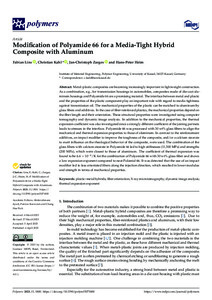| dc.date.accessioned | 2023-05-05T10:59:08Z | |
| dc.date.available | 2023-05-05T10:59:08Z | |
| dc.date.issued | 2023-04-06 | |
| dc.identifier | doi:10.17170/kobra-202305057948 | |
| dc.identifier.uri | http://hdl.handle.net/123456789/14660 | |
| dc.description.sponsorship | Gefördert durch den Publikationsfonds der Universität Kassel | ger |
| dc.language.iso | eng | |
| dc.rights | Namensnennung 4.0 International | * |
| dc.rights.uri | http://creativecommons.org/licenses/by/4.0/ | * |
| dc.subject | plastic–metal hybrids | eng |
| dc.subject | fiber orientation | eng |
| dc.subject | X-ray microtomography | eng |
| dc.subject | dynamic image analysis | eng |
| dc.subject | thermal expansion exponent | eng |
| dc.subject.ddc | 530 | |
| dc.title | Modification of Polyamide 66 for a Media-Tight Hybrid Composite with Aluminum | eng |
| dc.type | Aufsatz | |
| dcterms.abstract | Metal–plastic composites are becoming increasingly important in lightweight construction. As a combination, e.g., for transmission housings in automobiles, composites made of die-cast aluminum housings and Polyamide 66 are a promising material. The interface between metal and plastic and the properties of the plastic component play an important role with regard to media tightness against transmission oil. The mechanical properties of the plastic can be matched to aluminum by glass fibers and additives. In the case of fiber-reinforced plastics, the mechanical properties depend on the fiber length and their orientation. These structural properties were investigated using computer tomography and dynamic image analysis. In addition to the mechanical properties, the thermal expansion coefficient was also investigated since a strongly different coefficient of the joining partners leads to stresses in the interface. Polyamide 66 was processed with 30 wt% glass fibers to align the mechanical and thermal expansion properties to those of aluminum. In contrast to the reinforcement additives, an impact modifier to improve the toughness of the composite, and/or a calcium stearate to exert influence on the rheological behavior of the composite, were used. The combination of the glass fibers with calcium stearate in Polyamide 66 led to high stiffnesses (11,500 MPa) and strengths (200 MPa), which were closest to those of aluminum. The coefficient of thermal expansion was found to be 6.6 × 10-⁶/K for the combination of Polyamide 66 with 30 wt% glass fiber and shows a low expansion exponent compared to neat Polamid 66. It was detected that the use of an impact modifier led to less orientated fibers along the injection direction, which resulted in lower modulus and strength in terms of mechanical properties. | eng |
| dcterms.accessRights | open access | |
| dcterms.creator | Kahl, Christian | |
| dcterms.creator | Lins, Fabian | |
| dcterms.creator | Zarges, Jan-Christoph | |
| dcterms.creator | Heim, Hans-Peter | |
| dcterms.extent | 13 Seiten | |
| dc.relation.doi | doi:10.3390/polym15071800 | |
| dc.subject.swd | Kunststoff-Metall-Verbund | ger |
| dc.subject.swd | Wärmeausdehnung | ger |
| dc.subject.swd | Polyamid 66 | ger |
| dc.type.version | publishedVersion | |
| dcterms.source.identifier | eissn:2073-4360 | |
| dcterms.source.issue | Issue 7 | |
| dcterms.source.journal | Polymers | eng |
| dcterms.source.volume | Volume 15 | |
| kup.iskup | false | |
| dcterms.source.articlenumber | 1800 | |


